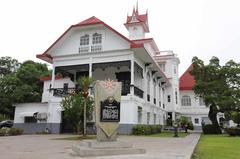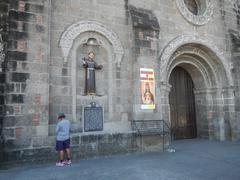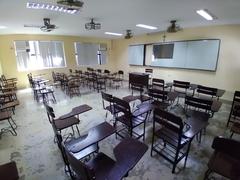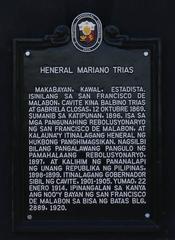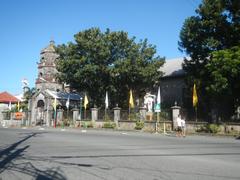House Where Andres Bonifacio Stayed Historical Marker
Visiting the House Where Andres Bonifacio Stayed: A Comprehensive Guide to General Trias’ Revolutionary Heritage
Date: 14/06/2025
Introduction
Nestled in the heart of General Trias, Cavite, the House Where Andres Bonifacio Stayed is a living testament to the Filipino spirit and the fight for independence. This Spanish colonial “bahay na bato” served as a vital hub during the Philippine Revolution, providing shelter and strategic ground for the revolutionary leader Andres Bonifacio and his compatriots. Today, an official historical marker preserves its legacy, drawing history enthusiasts, students, and travelers eager to connect with the nation’s past (Camella; NCCA).
General Trias, formerly known as San Francisco de Malabon, played a decisive role in the revolution, hosting landmark events such as the “First Cry of Cavite” and the Tejeros Convention—moments that shaped the nation’s trajectory (generaltrias.gov.ph; scribd.com). Although privately owned and not open for interior tours, the house’s well-preserved façade, period architecture, and the NHCP historical marker make it a significant stop on Cavite’s heritage trail.
This guide provides an in-depth look at the site’s history, architectural features, visiting details, accessibility, nearby attractions, and practical travel tips.
Contents
- Origins and Historical Context
- Bonifacio’s Stay and Revolutionary Role
- Architecture and Cultural Significance
- The NHCP Historical Marker
- Connections to Other Revolutionary Sites
- Visitor Information
- Visiting Hours & Tickets
- Directions
- Accessibility
- Guided Tours & Events
- Travel Tips
- Nearby Attractions
- FAQs
- Conclusion & Recommendations
- Sources
Origins and Historical Context
General Trias was established in 1748 and renamed in 1920 to honor General Mariano Trias, a prominent revolutionary leader (1library.net; generaltrias.gov.ph). The town was a hotbed of revolutionary activity, witnessing crucial assemblies and uprisings that catalyzed the Philippine Revolution.
The house itself exemplifies Spanish colonial architecture: an adobe and red brick ground floor supporting a wooden upper story, capiz shell windows, and an overhanging clay tile roof—all distinctive features designed for the tropical climate and seismic activity (Camella; angelfire.com).
Bonifacio’s Stay and Revolutionary Role
During the revolution, Andres Bonifacio—founder of the Katipunan—sought sanctuary in this house while collaborating with Cavite leaders like Mariano Trias and Emilio Aguinaldo. These meetings led to strategic planning ahead of the Tejeros Convention, a turning point in the struggle for independence (scribd.com). The house became a silent witness to debates and decisions that would alter the revolutionary movement’s course.
Architecture and Cultural Significance
A classic “bahay na bato,” the house features:
- Stone and Adobe Ground Floor: Provides strength and fire resistance.
- Wooden Upper Floor: Flexible and cool, ideal for gatherings and family life.
- Capiz Shell Windows: Allow light and airflow while maintaining privacy.
- Overhanging Roof (Tejas): Shields walls from tropical rain and sun.
- Ornamental Details: Wooden carvings, wrought iron grills, and ventanillas for ventilation.
This architecture is not just aesthetic; it reflects Filipino resilience, adaptability, and the blending of local and colonial influences (Camella; Bluedreamer27).
The NHCP Historical Marker
Installed by the National Historical Commission of the Philippines (NHCP), the marker commemorates Bonifacio’s stay and the house’s association with other key figures, including Emilio Aguinaldo and several Philippine presidents (wikidata.org). This recognition ensures the site’s preservation and educates visitors about its role in national history (NHCP Historic Sites).
Connections to Other Revolutionary Sites
General Trias and the surrounding area are rich in revolutionary landmarks:
- Bonifacio Trial House (Maragondon): Site of Bonifacio’s court-martial and execution (Inquirer Lifestyle).
- Tejeros Convention Site: Where revolutionary leadership was contested (boyplakwatsa.wordpress.com).
- St. Francis of Assisi Parish Church: Another heritage site in General Trias (Bluedreamer27).
These sites collectively narrate Cavite’s pivotal role in the revolution (Camella).
Visitor Information
Visiting Hours & Tickets
- Exterior Viewing: Accessible any time during daylight hours.
- Interior Access: Not available; the house is privately owned.
- Admission: No fees for viewing the façade and marker.
Directions
- By Private Vehicle: From Manila, take SLEX (Carmona Exit) then Governor’s Drive to General Trias. Parking is available near the town center.
- By Public Transport: Buses and jeepneys run from Metro Manila to General Trias. From the Poblacion, the marker is within walking distance.
Accessibility
- Surroundings: Flat and walkable; suitable for most visitors.
- Wheelchair Access: The exterior is accessible, but interiors feature historic staircases and are closed to the public.
Guided Tours & Events
- Guided Heritage Walks: Occasionally organized by local tourism offices, often including the house and nearby attractions.
- Special Events: Bonifacio Day (Nov 30) and Independence Day (June 12) feature reenactments and educational programs.
Travel Tips
- Wear comfortable walking shoes.
- Bring water, sun protection, and a camera.
- Respect residents’ privacy and preservation rules.
- Check the General Trias tourism website or Audiala app for updates on events and possible guided tours (Audiala).
Nearby Attractions
- St. Francis of Assisi Parish Church
- General Trias Town Plaza
- Bonifacio Trial House, Maragondon
- Tejeros Convention Site
These can be combined into a heritage tour for a fuller experience of Cavite’s revolutionary sites.
Frequently Asked Questions (FAQs)
Q: Can I enter the house to see the interiors?
A: No, the house is privately owned and not open for public tours. The exterior and marker are viewable from the street.
Q: What are the visiting hours?
A: The marker and façade are accessible during daylight hours.
Q: Is there an entrance fee?
A: No, viewing the exterior is free.
Q: How can I arrange a guided heritage walk?
A: Contact the General Trias tourism office or check the Audiala app for scheduled walks.
Q: Is the site accessible to persons with disabilities?
A: The exterior is accessible, but the historic structure’s interiors are not open or wheelchair-friendly.
Conclusion & Visitor Recommendations
The House Where Andres Bonifacio Stayed is a key destination for anyone seeking to understand Cavite’s and the nation’s revolutionary heritage. While interior access is restricted, the preserved façade, historical marker, and central location make it a powerful site for reflection and learning. Combine your visit with other historical landmarks for a deeper exploration of the Katipunan’s legacy.
For the best experience, visit during commemorative events, engage with local guides, and utilize digital resources like the Audiala app. Always respect preservation efforts and the privacy of current residents. Your journey to this historic landmark is not just a visit—it’s a step into the narrative of Filipino courage, unity, and the enduring quest for independence.
Sources for Further Reading
- History of General Trias, General Trias Official Website
- Revisiting the Saint Francis of Assisi Parish, Bluedreamer27
- A Walk Into the Past of Cavite: The Land of the Brave, Camella
- Andres Bonifacio and the 1896 Revolution, NCCA
- Cavite Land Shrines & Monuments, Inquirer Lifestyle
- History of General Trias, Scribd
- NHCP Historic Sites Blog
- House Where Andres Bonifacio Stayed Historical Marker, Wikidata
- Audiala General Trias Guide
- Bonifacio Trial House, Lamudi Journal
- Tejeros Convention Posts, Boyplakwatsa Blog
